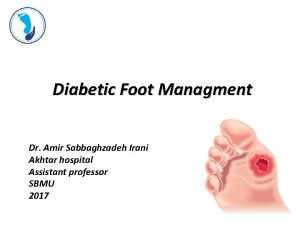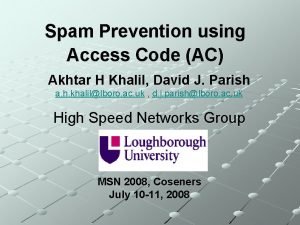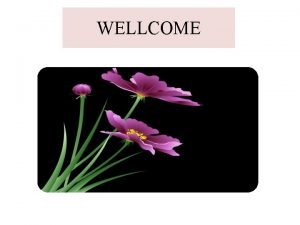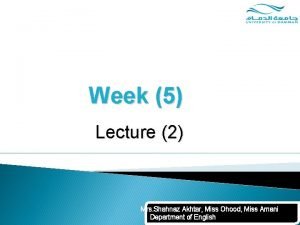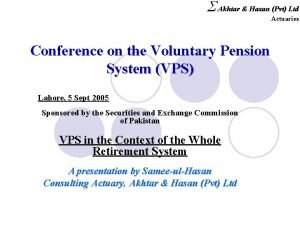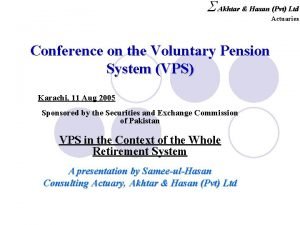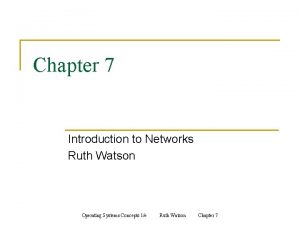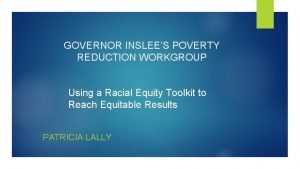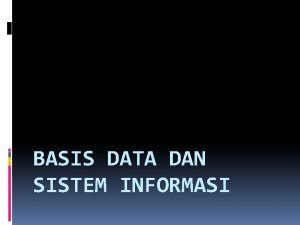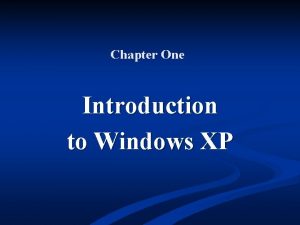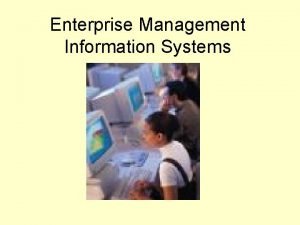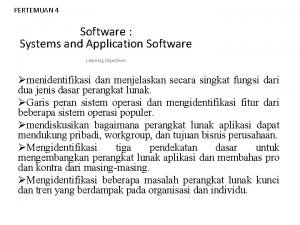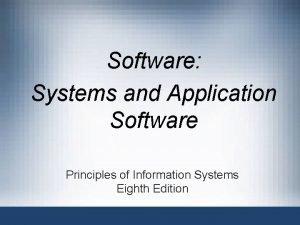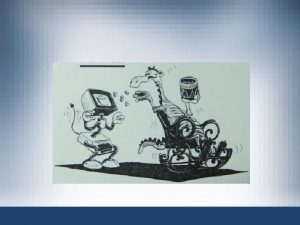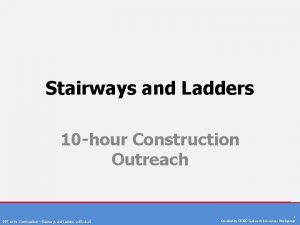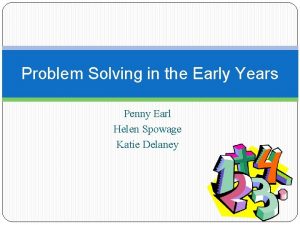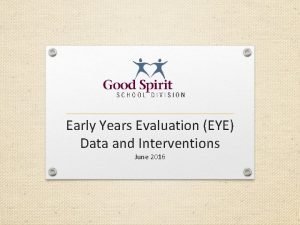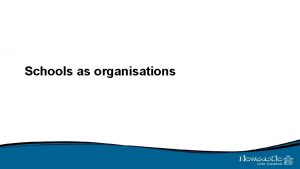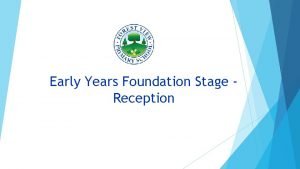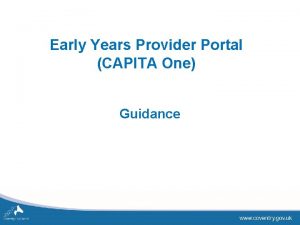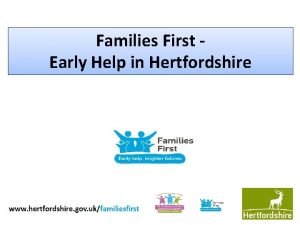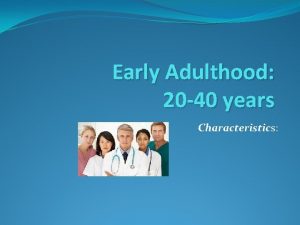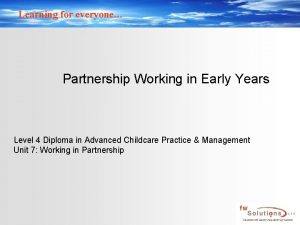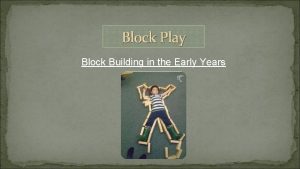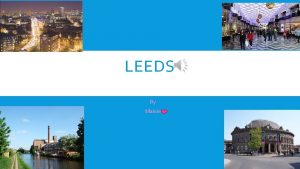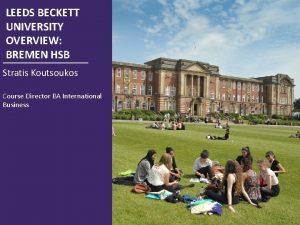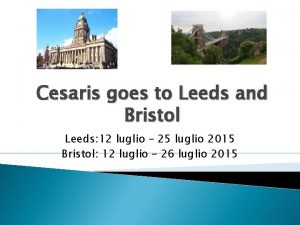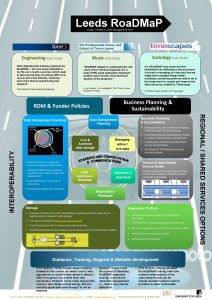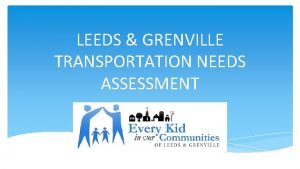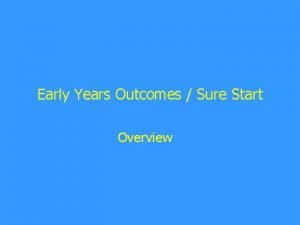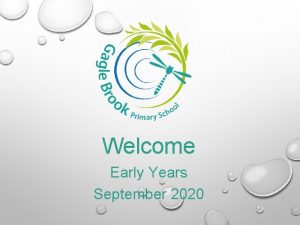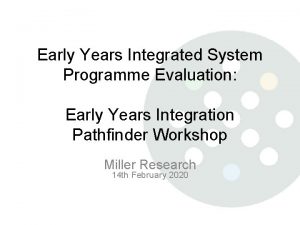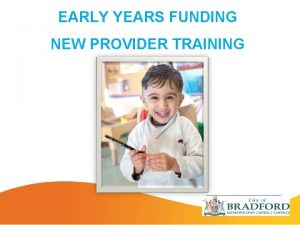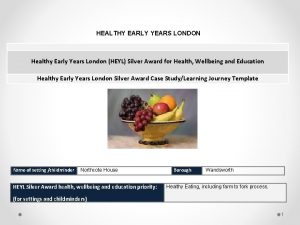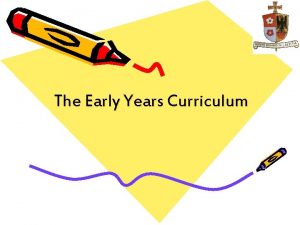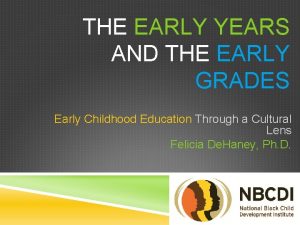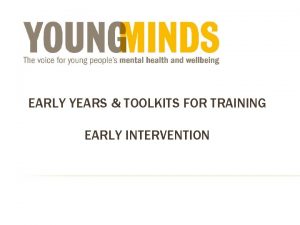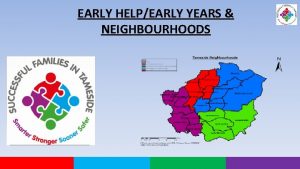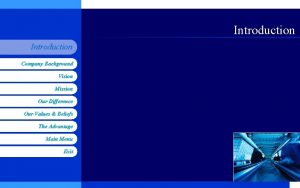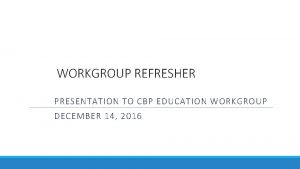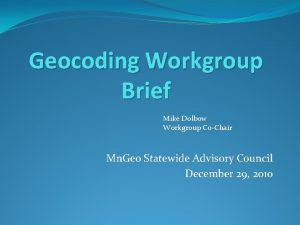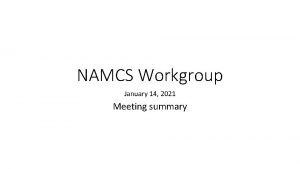Leeds Early Years Workgroup July 2019 Refhet Akhtar










































- Slides: 42

Leeds Early Years Workgroup July 2019 Refhet Akhtar Early Years Consultant, Learning Improvement Sarah Coltman Primary Consultant Learning Improvement

Outline of the day 9: 30 - 10: 00 Welcome and overview of the workgroup 10: 00 - 10: 45 Pre counting 10: 45 - 11: 00 Break 11: 00 - 12: 00 Counting 12: 00 - 12. 30 Pattern 12: 30 - 1: 15 Lunch 1: 15 - 2: 15 Number 2: 15 Comfort break 2: 30 – 3: 30 NCETM, gap task, planning and evaluations


£ Why? Developing a new mindset for maths…… Practical, pervasive, context rich, intriguing, purposeful, language laden……

Standard for teachers’ professional development 1. Professional development should have a focus on improving and evaluating pupil outcomes. 2. Professional development should be underpinned by robust evidence and expertise. 3. Professional development should include collaboration and expert challenge. 4. Professional development programmes should be sustained over time. And all this is underpinned by, and requires that: 5. Professional development must be prioritised by school leadership. Df. E, July 2016

The importance of Early Mathematics It seems that children who bring early mathematical knowledge to school are advantaged in terms of their mathematical progress through primary school (e. g. Aubrey, Dahl & Godfrey, 2006; Young-Loveridge, Peters & Carr, 1997). A consequence is that students with little mathematical knowledge at the beginning of formal schooling remain low achievers throughout their primary years and probably beyond. Taken from Warren et al (2009)

What does mathematics look like in the Early Years? • Children work broadly at the same pace, – saturating the environment with mathematics • Children spend longer on concepts – maybe only numbers up to 5 in the first term. • The environment supports maths and adults know how to support children’s maths in SST

Developing subject knowledge learning about mathematical pedagogy • Are we clear what children know? • Do we sometimes wrongly assume they know more than they do? • What are the small steps in early mathematical learning • Do we have the knowledge to provide the right kind of scaffolding and opportunities?

An Approach to Early Maths 1. Mathematise the world 2. Make mathematics more than manipulatives 3. Recognise receptive understanding (receptive/ productive understanding) 4. Get mathematics into children’s ears, eyes and feet 5. Provide scaffold - children to construct their own understanding Erikson Institute 2014

Impact on children’s learning from previous cohorts • Children have a deeper understanding of number • They can explain their thinking • Teachers enjoy maths more • EY pedagogy maintained • Children Y 1 ready

End of year expectations for Early Years Children count reliably with numbers from one to 20, place them in order and say which number is one more or one less than a given number. Using quantities and objects, they add and subtract two single-digit numbers and count on or back to find the answer. They solve problems, including doubling, halving and sharing.

End of year expectations for Early Years NB In process of review Children count reliably with numbers from one to 20, place them in order and say which number is one more or one less than a given number. Using quantities and objects, they add and subtract two single-digit numbers and count on or back to find the answer. They solve problems, including doubling, halving and sharing.

Pilot Early Learning Goal FOR USE IN EYFSP PILOT SCHOOLS ONLY Number: Children at the expected level of development will: • Have an understanding of number to 10, linking names of numbers, numerals, their value, and their position in the counting order • Subitise (recognise quantities without counting) up to 5 • Automatically recall number bonds for numbers 0 -5 and for 10, including corresponding partitioning facts. Numerical Patterns: Children at the expected level of development will: • Automatically recall double facts up to 5+5 • Compare sets of objects up to 10 in different contexts, considering size and difference • Explore patterns of numbers within numbers up to 10, including evens and odds.

Transition to Year 1 - findings Many children cannot find one less in the context of a practical problem. Many children struggled to connect objects displayed with numerals on a track. Have children really met the ELG for counting? Pupils range of experience Teacher Subject Knowledge Mastery of ELGs

Y 1 Lesson Five is more than three Three is less than five

Developing number through tidying up • • • Nominate lead person in your group Nominate a scribe Read article Gather key points Lead person prepare to give synopsis Do other groups have anything new to add…. . https: //nrich. maths. org/11528

Now what? idea 1 idea 2 Do all staff have good mathematical subject knowledge? Is Maths embedded in your routines? idea 3 idea 4 How? How often, How many? How?

The Yorkshire Ridings Early Years Maths Hub Project Counting

Early mathematical experiences Sorting objects into sets and categories. This is the first stage of learning to count; to be able to identify and separate off the members of a set in order that you can count just these objects and no others. Rich experience of talk We should not underestimate the importance of the child having a rich experience of talk using language such as ‘one more’ and ‘another one’, within the context of the family home. When a child learns at a young age to ask for ‘another one’ , they are getting essential prerequisite experience for learning to count. Teachers should be aware of the significance of their own repetition of phrases such as ‘one more, then no more’.

Early mathematical experiences Ability to distinguish between small numbers Before they engage in actual counting children should be able to distinguish between small numbers, such as one, two and three. Three year olds will be able to look at a picture book and be able to recognise which picture has one cow, two cows, three cows. They are beginning to learn that numbers are used to describe sets of various sizes. This is also experienced when small numbers are used in conversation. Before they can count, children know that they have two feet and two eyes but only one nose. They have heard stories about three little pigs and three bears. Haylock and Cockburn

Pre counting experiences-language Sort the street Noticing Same and different Language https: //nrich. maths. org/5157

Now what? idea 1 idea 2 Do all staff have good mathematical subject knowledge? Is Maths embedded in your routines? idea 3 idea 4 How? How often, How many? How?


Counting Experiencing what it means to learn to count

Experiencing what it means to learn to count We have a new number system i h g f e d c b a

Experiencing what it means to learn to count Show me i a b h

Experiencing what it means to learn to count Calculate i added to h

Experiencing what it means to learn to count Calculate c subtract g

Experiencing what it means to learn to count Would it have been helpful if you had known something else first?

Compare the two images

Considering pedagogy…. How do you teach number?

Counting: a deceptively simple skill Many people consider counting to be a simple skill, but that leads us to be deceived – we often hear young children recite a string of words and assume they can count. (Penny Munn 1977)

Counting Every Child counts https: //www. youtube. com/watch? v=OBsjbp Fji. Ak

What is counting? Discuss what you have learnt through reading the article by Judy Sayers, the work of Penny Munn and the video we have just watched. Can you make a list of counting principles? Nominate lead person Scribe Gather key points Lead person prepare to give synopsis

Counting Principles Children have to learn how to do a number of things consistently in order to count successfully. These are the counting principles. Stable order The stable order principle refers to the understanding that numbers must always be said in the same order, i. e. 1, 2, 3, 4, 5 and not 1, 3, 2, 5, 4. Children count spontaneously from an early age, often saying the numbers in the wrong order. Collaborative play with an adult or older child helps them to develop stable order counting. Counting things out loud and making deliberate mistakes is very effective in helping children to learn the correct counting order. One-to-one correspondence refers to the ability to match one object to one number consistently. Without this skill, children will not be able to understand how many objects are in a group (the cardinal value).

Counting Principles Cardinality Understanding the cardinality principle means that a child appreciates that the last number counted indicates how many things are in the set. Abstraction This states that the preceding principles can be applied to any collection of objects, whether tangible or not. Obviously, for young children learning to count it is easier if the objects are tangible and, where possible, moveable, in order to help them to distinguish the ‘already counted’ from the ‘yet to be counted’ group. To understand this principle, children need to appreciate that they can count non-physical things such as sounds, imaginary objects or even the counting words – as is the case when ‘counting on’. Order irrelevance Many young children think that counting from one end of a collection of items will give a different answer from counting from the other. Group counting games, along with opportunities to count many different things in different settings, helps them to appreciate that the order does not matter. This is a crucial piece of knowledge when calculating with much larger numbers.

Counting Principles Things to make explicit Connecting’ one more’ and ‘one less’ Basic principle to make explicit The next number after a given number is always one more More challenging is the complementary principle that the previous number is always one less The pattern in counting Counting beyond 20 1, 2, 3, 4, 5, 6, 7, 8, 9, 10, 11, 12, 13, 14, 15, 16, 17, 18, 19, 20, 21, 23, 24…. . Double counting 1, 2, 3, 4, 5, 6, 7, 8, 9, 10 -1, 10 -2, 10 -3, 10 -4, 10 -5, 10 -6, 10 -7, 10 -8, 10 -9, 20, 21. Not all numbers are counting numbers Some are labels eg. bus numbers, football shirts

Small steps Clements and Sarama https: //www. learningtrajectories. org/

Early oral counting Children say numbers from a very early age Fusion (2008) identified 5 stages in the early development of the word sequence of counting: String level – a continuous sound string Unbreakable list level – separate words but the sequence cant be broken and always starts at 1 Breakable chain level – child learns to be able to start at any point, essential if they are going to be able to count on Number chain level – sequence, count and cardinality are merged, so if you are counting from 3, 3 is the first no, 4 the second………… Bi-directional chain – child can say the numbers in either direction and start at any point Also see Clements & Sarama (2014)

Identifying counting strategies that children need to develop Reflect on children in your own class. • Do you think children are developing a complete suite of counting principles and skills? • Are there any gaps? • What support do children need? • Does the whole team have the SK to do this?

Now what? idea 1 idea 2 idea 3 Do all staff have good mathematical subject knowledge? Is Maths embedded in your routines? Consider all aspects of counting. Begin to create a comprehensive list. idea 4 How often, How many? Which ones need to be accomplished first? Can you begin to put some of them in order? How?

Lunch Break See you soon
 Tanweer akhtar
Tanweer akhtar Munim akhtar
Munim akhtar Dr amir akhtar
Dr amir akhtar Dr akhtar khalil
Dr akhtar khalil Naheed akhtar md
Naheed akhtar md Dr shahnaz akhtar
Dr shahnaz akhtar Akhtar & hasan actuaries
Akhtar & hasan actuaries Farheen akhtar
Farheen akhtar Akhtar and hasan
Akhtar and hasan Marham by muniza akhtar
Marham by muniza akhtar Kofax clarity
Kofax clarity Jenis sistem informasi
Jenis sistem informasi Diff between workgroup and domain
Diff between workgroup and domain Workgroup cluster
Workgroup cluster Advantages of workgroup computing
Advantages of workgroup computing Domain vs workgroup
Domain vs workgroup Poverty reduction workgroup
Poverty reduction workgroup Shoretel salesforce
Shoretel salesforce Personal computer database vs workgroup database
Personal computer database vs workgroup database Workgroup vs domain pros and cons
Workgroup vs domain pros and cons Workgroup sphere of influence
Workgroup sphere of influence Enterprise information system adalah
Enterprise information system adalah Off the shelf application software examples
Off the shelf application software examples Application software explanation
Application software explanation Workgroup sphere of influence
Workgroup sphere of influence Side rails ppt
Side rails ppt Four score and twenty years ago
Four score and twenty years ago Goat years to human years
Goat years to human years 300 solar years to lunar years
300 solar years to lunar years Penny earl and mark
Penny earl and mark Eye early years evaluation
Eye early years evaluation Summarise types of early years provision
Summarise types of early years provision Early years foundation stage pack
Early years foundation stage pack Coventry early years portal
Coventry early years portal Mark making early years
Mark making early years Henry hudson netherlands
Henry hudson netherlands Families first assessment
Families first assessment Developmental milestones 20-40 years
Developmental milestones 20-40 years Big builders medway
Big builders medway Early years of william shakespeare
Early years of william shakespeare Partnership working in early years
Partnership working in early years Block play early years
Block play early years Services for young children hampshire
Services for young children hampshire


